|
|
Location and Establishment of Neyphug Monastery
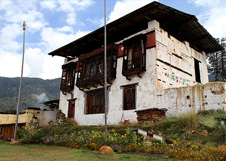
The First Neyphug Trulku established Neyphug (Heyphug) Monastery in 1550 at the Celestial land of Chuden, west of the capital Thimphu, Kingdom of Bhutan. It falls under the Shar Block of Paro district.
Neyphug Monastery is also known as Thegchen Choling (Dharma Land of Vajrayana). When Guru Padmasambhava personally set foot on this land during the 8th Century, he tamed the local harmful spirits and left imprints of his hands and foot on rocks. He also concealed several treasure teachings, samaya substances and other precious material substances here. Since then, the name of this area has been known as Neyphug, "the sacred hermitage cave." Today, it is also popularly known as Heyphug after the village it is situated in.
About an hour walk towards the south of the monastery is the Stupa that contains the relics of Buddha Mahakasayapa (Protector of Light). It is said that this Stupa is blessed no lesser than Phagpa Shinkun pagoda in Nepal. About a three-hour walk to the right of the monastery is the Self-arisen Stone Stupa at the residential monastery of master Drugchen Gyalwang who was Avalokitesvara in human form. A three-hour walk from the backside of the monastery is the sacred hermitage Samten Tsemo (Pinnacle of Concentration), also popularly known as Bumree. Yongdzin Ngawang Dragpa, the founding master of Neyphug Monastery attained realization of the Mahamudra (the Great Seal) and turned the Dharma wheel of teachings here. Half-an-hour walk from the left of this monastery is the Menchunang, the residential monastery of the great Pandit Jamyang Palden Gyatso who was the emanation of the Great Compassionate One (Avalokitesvara).
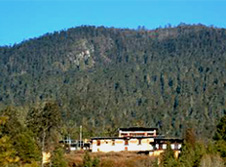
Majestically surrounded by these sacred places, many accomplished masters, such as Drupthop Chagzampa, the extraordinary being Barawa, the lord of Dharma Kunga Legpa, Trulku Paljor Gyaltshen, Drung Drung Rinchen Choedor, Gyalwang Sogdogpa, set foot on this land and was immensely blessed. This place is so sacred that the grounds bear wish-fulfilling trees, drops of nectar appear from the rocks, mantras spontaneously appear on rocks, and it is endowed with several miraculous marks that indicate that the Celestial Land is hidden here. Details of other sacred places of wonder starting from the gate to this holy hermitage can be found in "Guide to Neyphug Hermitage".
After Yongdzin Ngawang Dragpa perfected his enlightenment at Samten Tsemo (Bumree), he was travelling around establishing several seats of spiritualism for the purpose of benefiting sentient beings when the patrons of Heyphug village invited him to this place. Upon arriving here, he remembered his previous incarnation as Drugpa Joden, and even introduced the throne on which he taught the teachings, and pointed out very clearly all of his patrons of that time. This enabled his patrons to recognize him as the reincarnation of their previous Root Guru. Thus, his patrons developed uncontrived faith in him and felt remorse towards the cyclic existence and earnestly begged the master to establish a major monastery here. They also pledged to support the running of this monastery through all later generations. Thus, the present two-storey temple symbolically furnished with "Ten and Tenpa" (temple as the support and the statues that depend on this support) was built in 1550, and all the Neyphug Trulkus have been using this monastery as their principle seat since then.
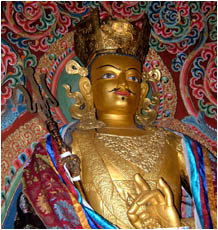
Representations of Enlightened Body, Speech, and Mind in the Monastery
The first Neyphug Trulku built Neyphug Thegchen Tsemo Monastery in 1550. The main shrines of Neyphug Monastery consist of the life size statue of Guru Padmasambhava sculptured during the First Neyphug Trulku (16th century) and the golden statue of Buddha Vajrasattva. The Monastery houses one of the extremely sacred Five Envoy-statues of Guru Padmasambhava (8th century). It is said that when Guru Rinpoche was about to depart for the southwest land of cannibals, King Mutig Tsenpo of Tibet persistently requested that he should leave something behind to represent him. At this request, Guru took alloy of five jewels and Atrong clay (medicinal soil which has three tastes of sweetness, sourness and bitterness) of Lake Manasarovar, and had these statues made by Acharya Shantarakshita. Acharya made the statues under the direction of Guru and in his image, and each of them wore a different costume, the five costumes of Zahor, Nepal, India, Tibet and China. Guru's statue clad in Chinese costume was concealed inside the Jowo (Buddha Sakyamuni) statue at Kyichu Monastery in Paro. Terton Pemalingpa foretold of this and at his prophecy and at his spiritual son Thugse Dawa's insistence, Terton Ngawang Dragpa, the First Neyphug Trulku, revealed it from the Jowo statue and it is the most sacred shrine at Neyphug Monastery today.
|
The "Catalogue of Neyphug Monastery" quotes the actual words of Guru Padmasambhava that speak about the benefits of seeing these five statues as follows:
Whoever sees or gets blessing from these statues, It is no different than seeing me, Guru Padmasambhava!
As for the temporal, they grant whichever common attainment one may wish for, And ultimately, to the abode of myself, Padmasambhava, Escorted with honor by assembly of Dakas and Dakinis, Will be brought to the Supreme Celestial Mansion of Lotus Luminosity!
Even the places where these statues are kept, Would have no difference as that of the Celestial Mansion of Lotus Luminosity! Huge gathering of Dakas and Dakinis will take place, Auspiciousness would pervade everywhere and there will be bountiful crops and cattle, The kalpa (eons) of sickness, war, and famine would soon get over!
|
The monastery grants audience of this statue once a year during the annual puja of the monastery that is held in the Second Month of the Bhutanese lunar calendar. The monastery also has the shoes worn by Guru Padmasambhava, the ritual hat of Zahor worn by the First Yangsi, his Do-akham (a piece of stone shaped over the palm of the by clenching fingers), and a clay-statue of Manjushri which is said to have come flying from Tibet by itself.
Furthermore, the top floor of the temple is furnished by the statues of Guru Padmasambhava, Vajrasattava, Amitayus, two statues of Eleven-faced Avalokitesvara, the eight statues depicting Guru's manifestations sculptured by the Fourth Yangsi, and the lineage holding gurus of the Kagyu tradition. In the protector's chapel are the Rishi Rahula's Tendoe, its statues and scroll paintings of Rahula protectors.
The wall paintings of the top floor include the eight manifestations of Guru Padmasambhava, the assembly of deities according to "The Diamond Garland Instructions of Long-life," the assembly of deities according to the "Quintessential Realization of the Gurus, " the family of eight Gods of Wealth, the three deities of longevity - Buddha Amitayus, Tara and Ushnisha Vijaya, the protector of three families - Avalokitesvara, Manjushri and Vajrapani, and also the painting depicting the masters of Nyingma and Kagyu tradition who were connected to this monastery.
The temple's ground floor holds the statues of the Buddhas of the three times of past (Buddha Kasayapa), present (Sakyamuni) and future (Matrieya), and the Kangyur (injunctive canon of Buddha) that was handwritten by the Second Yangsi. A Bodhisattva completed the images of the 1,002 Buddhas of the fortunate eon on the walls of the temple in one single night. Of these, the large image of Buddha Sakyamuni is said to have spoken prophetic words. The protector's chapel on this floor contains the statues of Ekadzati, the five classes of Damchen, Tendoe and statues of the five Gyalpo spirits that was constructed by the Fifth Yangsi. The stream of blessings from all these exceptional statues and relics pervades. Anyone with unwavering faith and devotion can surely receive the common and uncommon blessings and attainments by seeing them! However, the buildings of the Monastery have fallen into disrepair and it is Rinpoche's wish to start the reconstruction and redevelopment of Neyphug Monastery. Construction work to commence in September, 2006.
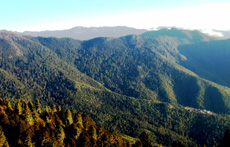
Turning the Wheel of Dharma - Rituals conducted at Neyphug Monastery
A new monk school was inaugurated at the Monastery in 2006. However, funds are still being raised for the immediate need of a school, housing and toilet facilities for the entering monks. The monastery is responsible for the food, clothing, education, medical care, and the entire welfare for all the monks. As such, the Monastery faces great financial challenges and depends solely on donations from generous benefactors and sponsors. Daily prayers of Green Tara, Medicine Buddha, and Lung-Ta are dedicated to the sponsors for attainment of good fortune, good health, and success.
Continuous religious rites and rituals are conducted at Neyphug Monastery. Some of the major traditional events are listed below. On the 3rd Day of the First Month of Bhutanese lunar calendar, the monastery conducts a ceremony to commemorate the anniversary of Terton Pemalingpa. On the 8th Day of the Second Month, the monastery conducts rituals to commemorate the anniversary of the First Neyphug Trulku, Yongdzin Ngawang Dragpa. The audience of the "Envoy-statue of Guru Padmasambhava" is granted to the public during this festival.
Preparations start from the 4th Day of the Third Month, the 6th Day commemorates the anniversary of Seventh reincarnation, Namdrol Dorje, on the 7th Day, rituals of Avalokitesvara and recitation of its mantra are held in the morning session followed by the performing of ten-day rituals according to the "Quintessential Realization of the Guru" in the afternoon. The rituals of "Diamond Garland Instructions of Long-life" are also held and all these ceremonies take a total of nine days. At the end, ritual dances are performed from the13th to the 15th Day of the Bhutanese calendar.
On the 15th Day of the Fourth Month, liturgical offerings to the 16 Arhats, Neyten Chudrug, and the Confessional offerings to the Dharma Protectors are held. On the 10th Day of the Fifth Month, the birth date of Guru Padmasambhava is celebrated. From the 7th through the 15th Day of the Seventh Month, Confessional Rituals of the Dharma Protectors are held. On the top floor of the temple, Confessional Ritual of Rahula is conducted while rituals of Ekadzati and Doechog ritual of the Gyalpo spirits are held on the ground floor. These rituals take a total of nine days. On the 29th Day of the Tenth Month, Torma Exorcism of Wrathful Guru and Vajra Kilaya are held alternatively. On the 18th Day of Eleventh Month, anniversary of the Sixth Yangsi, Sherab Gyaltshen, is observed.
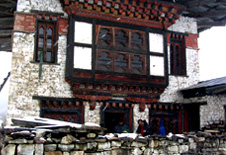
All these events are conducted for the purpose of spreading the Buddha Dharma firmly and extending the lives of the Dharma-holders, and in particular, the Tsa-wa-sum, King, country and People of Bhutan, and the Dharma patrons to fulfill their wishes spontaneously and to enjoy a life free from war, internal strife, natural calamities, misfortunes and epidemics.
Rendering top priority to these objectives, the monastery thus opens the profound mandalas, the exceptional deities are visualized by the means of two stages of generation and completion, mantras are recited, supplications are made, and the enlightened deities are invocated in order to beseech the granting of the common and uncommon attainments!
May the Buddha's teachings, the source of all temporal and ultimate benefit pervade the ten directions and prevail in the three times! May the Yangsi Rinpoche and the supreme upholders of Buddha Dharma live long and may their noble wishes be fulfilled!
As my veneration and New Year gift to the Yangsi Rinpoche, I, Lopon Phuntsho Gyaltshen of Ngagyur Nyingma Institute translated this at the end of December, 2003.
Humbly edited and updated by Karma Janhchub Pemo, October, 2006.
|
 Contact Us | Sitemap
Contact Us | Sitemap Contact Us | Sitemap
Contact Us | Sitemap